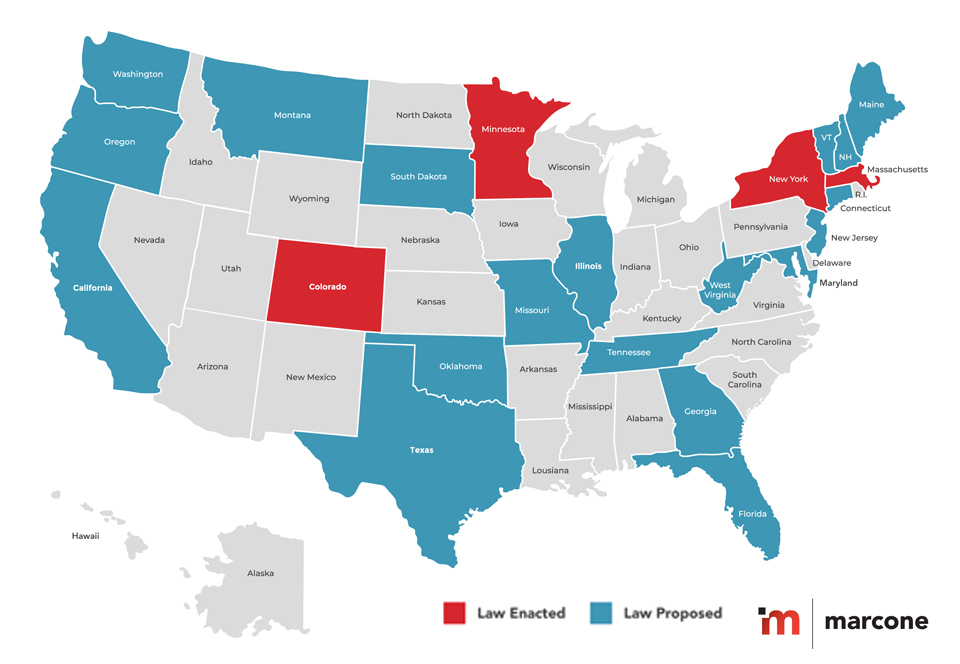Right to Repair: Breaking Down a Complex Issue
As lawmakers nationwide consider Right to Repair regulations, the repair industry faces its own set of questions, from product liability to intellectual copyright protection.
Editor's Note: This column, written by Marcone's
VP of Business Development Kippy MacNulty,
is the latest in an ongoing series of contributed
editorial columns. Readers interested in authoring
a contributed column in the future can
click here, scroll to the bottom, and click "Contributors" to
see the Guidelines for Editorial Submissions page.
By Kippy MacNulty, Vice President of Business Development, Marcone Group.
Imagine this: It's the summer of 1978 and you're getting ready to leave on a family road trip when the engine in your station wagon begins to knock. You realize the car is particularly sluggish when accelerating and rough when idling.
Basic mechanical skills tell you that's a spark plug problem, so you pop the hood and take a look. The spark plug looks good, but obviously something is preventing the coil from signaling the plug. So you check the point gap to make sure it isn't closed off. Maybe you file excess carbon off the tip of the points to create more space.
You drop the hood, fire up the engine and hear that motor begin to purr again. Vacation is on and you're back in business.
Now fast-forward that scenario to 2023. This time it's an SUV with a knock and rough idling in the engine. It might be the spark plug, but it also could be the O2 sensor — something that simply didn't exist on that 1978 station wagon.
So, you drive to your local dealership to have the engine hooked up to a computer that will diagnose the problem. The electronic diagnostic identifies the faulty part, a certified mechanic swaps it out, and you're ready to hit the road again.
In both scenarios, the outcome was the same: a working car. But today's technological advancements make it difficult for that home mechanic to fix the problem in his driveway anymore. All of the add-ons that go into modern cars — emissions parts, backup cameras, airbags — have made them complex enough that computers are a key component of the repair process.
That shift is the reason there's an ongoing "Right to Repair" movement facing lawmakers across the country. Legislation in nearly half of the United States looks to make it easier for DIYers to repair their own devices and appliances by requiring manufacturers to provide parts and repair schematics to the public.
The idea is not without concern, however. Opponents say such measures pose public safety risks and generate intellectual property violations.
Regardless of where legislation lands, the Right to Repair movement could usher in a litany of unintended consequences. It remains to be seen what might happen to the cost and availability of repair parts, and who should be held liable if a repair doesn't hold.
Those issues — and many more — will be discussed in statehouses across the United States during the coming months, as legislators decide how to address the challenges that technology has brought to the repair industry.
Right to Repair: Pros and Cons

Map of U.S. States with enacted or proposed Right to Repair laws.
Fast Facts:
- At least 23 states have introduced Right To Repair bills. That number is growing rapidly in 2023.
- 84% of U.S. adults support the Right To Repair concept.
- New York was the first state to enact Right To Repair legislation.
From a legal standpoint, consumers already are able to repair their own equipment. However, the repair parts and schematics to do so are not readily available. That's what the Right to Repair movement aims to change.
The goal of both proposed and enacted legislation is to require manufacturers to provide public access to manuals, schematics, and software updates. Beyond that, consumer groups want products to be designed in such a way that they can be repaired — think of earbuds that are essentially broken once they are pulled apart.
Advocates say this solution is key to both the circular economy and green technologies. Extending product life span through repair appears to be an easy way to prevent an abundance of equipment in landfills. The potential misfire, of course, is if consumers use repairs as an incentive to keep old equipment that is less energy efficient. That would translate into a step down for the environment.
When President Biden issued an executive order in 2021 calling for the FTC to draft a Right to Repair law, a primary goal was to increase competition among manufacturers, improving products and service alike. And of course, it would give consumers increased control over their purchases.
On the other hand, consumer-driven repairs open manufacturers to a level of product liability they never intended to take on. Could they be held liable if someone is injured while trying to repair equipment? Who is responsible if the repair doesn't hold, or if the consumer is actually the one causing damage due to misuse?
Moreso, will manufacturers be asked to provide information that would disclose confidential intellectual property? Repair instructions could, in some cases, require a level of detail that could cause companies to lose their competitive edge.
There are also safety concerns. Would disclosing software data open consumers up to criminal hackers who have access to their sensitive information? Could an incorrect repair start a house fire or make a child's toy unsafe to use?
With both up- and downsides to Right to Repair legislation, there undoubtedly will be debate over this issue for years to come.
Varying Effects Throughout the Industry
Even businesses within the same supply chain have differing takes on Right to Repair legislation. It raises specific issues and has different implications for each sector, making it a sensitive topic for discussion.
From a manufacturing standpoint, Right to Repair would require repair parts to be available to consumers.
Already, manufacturers produce repair parts for their equipment. But they tend to prioritize distribution first to their authorized dealers, and next to outside operations. Often, that means there isn't a readily available supply to outside sources.
With consumers added to the mix, manufacturers will be in the awkward position of attempting to forecast demand for a brand-new market. The increased demand could also drive up the price of parts, making repairs more expensive, and potentially pushing consumers to replacement anyway.
From the perspective of a service provider, there's no question they would see the effect of this legislation on their business. The question is, would it be good or bad for business? The repair industry certainly would get a boost from consumers who otherwise might replace their products. However, the potential influx of unauthorized and possibly untrained repair providers could wreak havoc on the industry as a whole.
For warranty companies, it's always a benefit when an appliance can be repaired rather than replaced. Still, a top concern for the warranty industry will be how DIY repairs are covered and who is responsible if a repair fails. And if consumers are doing their own repairs, will they find as much value in extended warranties?
Consumer-performed fixes also can translate into a higher repair frequency — and increased costs — if they are based on DIY guesswork rather than technician diagnostics.
Finally, what will higher demand for repair parts do to the cost and availability in the marketplace? Warranty companies could be looking at a situation where their technicians are paying more and waiting longer for the same part, resulting in unhappy customers.
A Shifting Strategy
Regardless of what lawmakers decide, companies affected by Right to Repair need to establish pathways for navigating it. Businesses affected by Right to Repair legislation ultimately must position themselves for success within this potentially new framework.
That might require a shifting business strategy, one that focuses more on long-term consumer relationships rather than a single sale. If legislation is enacted, the companies who come out ahead will be those who have projected a particularly consumer-friendly image. That means providing video tutorials, easy-to-read schematics and a communication strategy that will impress consumers and make them return for future brand purchases.
Meanwhile, manufacturers can consider adjusting prices to offset any anticipated profit loss from the legislation. If their product has a high profit margin, they could lower prices in an effort to lessen the appeal of a repair option.
For more costly products, offering free repair or regular servicing might be a worthwhile bid, because it adds value to the product. It would also make any Right to Repair legislation moot because consumers would be using the manufacturer for repairs.
Another option is making certified repairs the most appealing option on the market for consumers by offering a quick turnaround and low cost. Any business strategy that makes DIY repair the least attractive option would minimize any negative impact from this legislation.
Finding a workaround for business success, regardless of where legislation lands, will be key for companies in the manufacturing, distribution, warranty, and service sectors. A nimble approach positions these industries to maintain profitability, even when the business-friendly environment declines.
Even now, developing consumer relationships is imperative to driving business back to the brand. At no time will that be more critical than during a push for DIY or independent repair. It reflects poorly on the business when a repair isn't done correctly or won't hold up. Establishing long-term partnerships looks to bring consumers back to OEMs and certified technicians, where they know quality parts and service will reign.
There's no doubt: Technology will continue to reign, and complicate these issues in the future. The time we put into strategic planning now will drive our success for years to come.
Right to Repair Q&A
What do proponents say? Legislation would lower consumer costs and be more environmentally friendly as products are reused instead of discarded.
What do opponents say? Legislation would raise safety concerns and infringe on intellectual property rights.
Which industries are facing this? Most manufacturers could face this at some point, but the biggest focus has been on digital electronics, cars, and agriculture equipment.
What are other countries doing? European Parliament is considering similar measures that promote repair over replacement of goods by making it easier for consumers to get repairs. In Canada, framework is being created to implement a Right to Repair law that would prevent manufacturers from using software copyright or digital locks on devices and appliances.
About the Author

Kippy MacNulty is the Vice President of Business Development for Marcone Group, North America’s leading distributor of appliance, HVAC, plumbing, commercial kitchen and pool/spa parts and equipment. Learn more about Marcone’s offerings at www.marcone.com.
Kippy is a seasoned professional with 25+ years of leadership in business, account management, marketing and operations, with more than half of that time in the Extended Warranty/Home Warranty space. With extensive experience in the global arena, she is also highly skilled at developing and maintaining solid relationships with international, national, and regional executives. Kippy is an accomplished professional with a proven track record of delivering powerful results across a broad range of B2B and B2C strategies.







